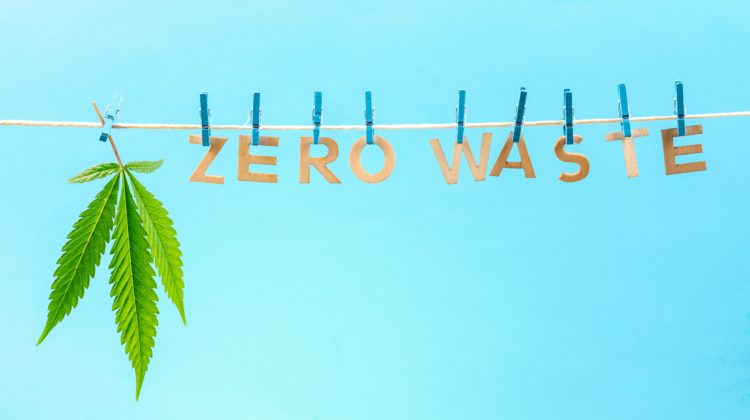
Credit: twenty20photos
As the cannabis industry has gained prominence in the United States, companies that manufacture cannabis-related products have attempted to reduce the industry’s ecological footprint.
One of these companies is Botani, a subset of the over 400-year-old paper manufacturing company Schweitzer-Mauduit International (SWM), that produces hemp-based cannabis paper products. Founded in 2021, SWM created Botani to introduce products into the cannabis marketplace.
Another company, Green Mill Supercritical, produces cannabis extraction equipment that has helped reduce the environmental impact of the cannabis industry. By using carbon dioxide, the company’s equipment makes extracting cannabis more efficient, and as a result more ecologically friendly.
Botani’s Sustainable Hemp-Based Products

Made from hemp leaf, Botani produces a wide-variety of cannabis paper products.
One of these products is hemp wrappers for blunts, joints, or CBD cigarettes.
According to Botani’s website, the hemp wrappers are self-adhering for blunt applications and moisture-optimized for safe storage and a long shelf-life. The company develops custom wrappers, including gummed and infused options.
Alex Boone, Botani’s managing director explained that moisture-optimized hemp wrappers help prevent mold. “What was on the (tobacco and cannabis) market previously is very high in moisture. Our product although has a higher level of moisture than standard paper, it’s not nearly as high and so it’s not as susceptible to molding.”
Botani also produces hemp fillers that are available in ready-to-use cut-rag and custom formats. These formats are for combustible, oral, Shisha, and heated style applications. The company also offers fillers infused with CBD, terpenes, or custom flavors upon request.
Further, the company produces hemp-based rolling papers in booklets, tubes, or cones.
Green Mill Supercritical’s Carbon Dioxide Extraction Equipment

Green Mill produces supercritical carbon dioxide extraction equipment. In order to extract cannabis, this equipment uses supercritical carbon dioxide, which is a carbon dioxide solvent in a state between gas and a liquid. As Green Mill’s CEO Wes Reynolds explained, supercritical carbon dioxide takes on an in-between ethereal property that can permeate a variety of different surfaces and materials.
Cannabis operators can use Green Mill’s extraction equipment to extract specific molecules such as CBD, THC, or terpenes.
Reynolds said, “A Cannabis operator would buy our system from us, and then they would put it in their facility. He continued, “It’s a series of stainless steel vessels that we put the plant material into. The vessel is ground up and dried and then the system moves CO2 to a supercritical state, and pushes it through the biomass. Then you can control the temperature flow rate and pressure of that (supercritical carbon dioxide) to target specific molecules through the process.”
In addition to cannabis, Green Mill’s extraction machines can extract materials from other plants, such as lavender and hops.

Green Mill’s Paralell Pro, Credit: Green Mill Supercritical
Benefits of Using Carbon Dioxide For Cannabis Extraction
According to Green Mill, although carbon dioxide is a greenhouse gas, extraction does not contribute to the climate-altering greenhouse effect. This is because carbon dioxide is withdrawn from and returned to the environment in the extraction process.
As Reynolds mentioned, carbon dioxide is a clean product that is not flammable, nontoxic, renewable, and abundant. Further, supercritical carbon dioxide extraction recollects carbon dioxide to avoid contributing to smog.
Before supercritical carbon dioxide extraction, the hydrocarbon ethanol was commonly used to extract cannabis. However using ethanol is a less clean process that can contaminate products.
Reynolds explained that carbon dioxide can help remove dangerous elements in cannabis, like hydrocarbons, allowing for a more natural product. “Carbon dioxide removes all those dangerous elements and it allows our customers to produce the most true product to the original plant intention.”
Reducing Waste Through Hemp Biomass
In order to reduce waste, Botani produces its products using post-extracted hemp biomass or hemp waste. This natural process of producing products involves intertwining the hemp fibers rather than gluing them together according to Botani’s website.
In 2021 SWM’s New York paper mill was revitalized to produce Botani’s products with new processes that reduce cannabis waste. The mill uses hemp flowers, stems, and trimmings to create 100% hemp-based paper
Boone told Emerald that Botani has formed a partnership with hemp farmers to buy their hemp biomass to make products. This ultimately economically benefits these farmers.
“We’ve actually created a new revenue stream for these farmers and extractors that we work with. Where they may have had to pay someone to get rid of something (biomass), we’re now paying them to take it. I think that that’s a part of sustainability, is making sure that the people are actually growing something can sustain their processes for a long time and invest in better ways in which they can do farming practices.”
So far, this method of production has successfully allowed Botani to convert a large quantity of hemp biomass into products. According to SWM’s 2021 Environmental, Social, and Governance (ESG) Report (page 22), “In its first year of availability, 70 metric tons of hemp waste were turned into saleable products and this is expected to grow in the future”
Action to Reduce Water Use and Energy Emissions
Since paper-making is water-intensive, SWM as a whole aims to reduce the amount of water used to make its products.
As Boone explained, “One of the key targets for the whole corporation, since we’re paper makers, is water reduction, and the use of water itself and reducing that in our process, which makes us more efficient overall in what we do, but it also helps the environment.”
According to SWM’s ESG report, the company as a whole uses recycled water to produce products. The report stated (page 19), “The water we withdraw from the area source is recycled, which optimizes its use, with efficient recovery enabling over 90% of the water to be returned to the environment or reused in the production process after appropriate treatment. The net consumption of water (typically less than 10% of the water withdrawn) is due to the water contained in the final product and to the loss of water during production (mainly due to evaporation). We have developed our manufacturing processes around the availability of recycled water in this way to maximize our operational efficiency, so we do not anticipate our dependency on recycled water to change in the future.”
The report also demonstrates SWM’s dedication to reducing energy emissions, specifically by incentivizing energy reductions.
Overall, Botani and Green Mill’s company practices and products are creating a more sustainable future for the cannabis industry.



Leave a Reply